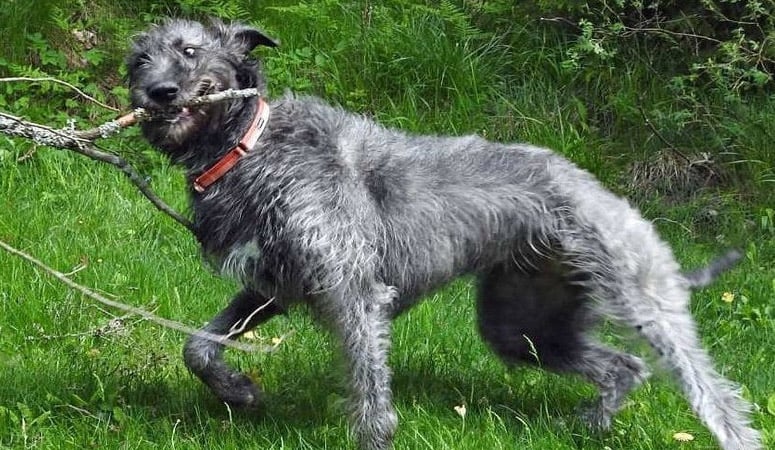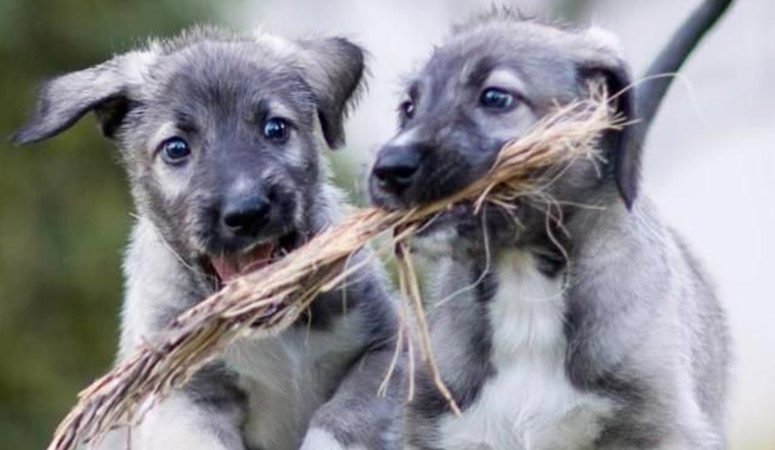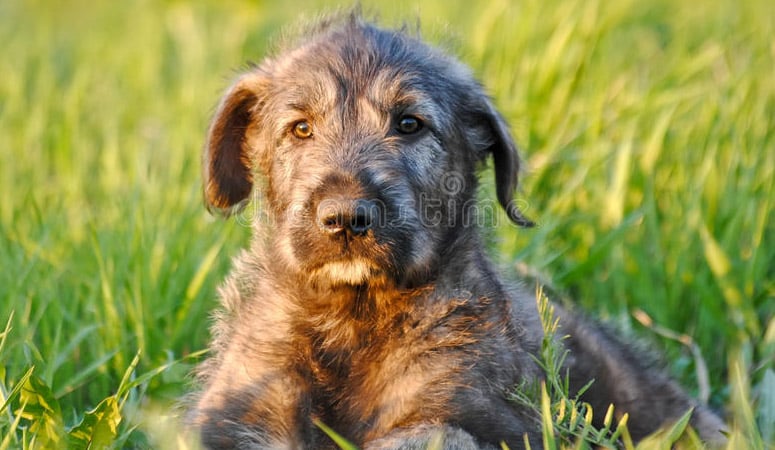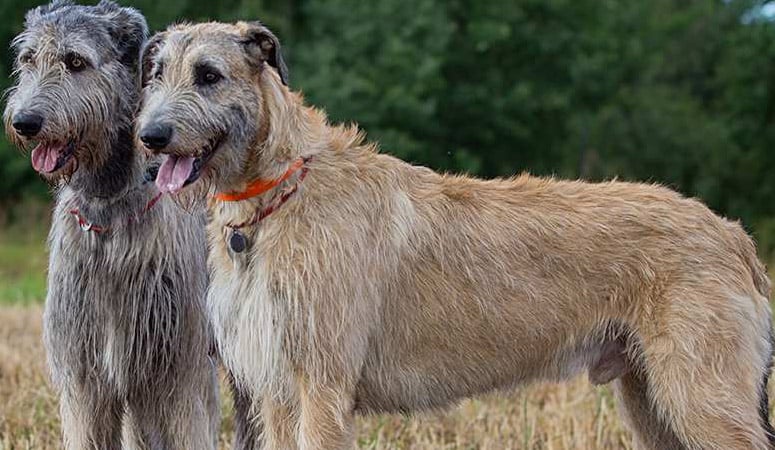Irish Wolfhound
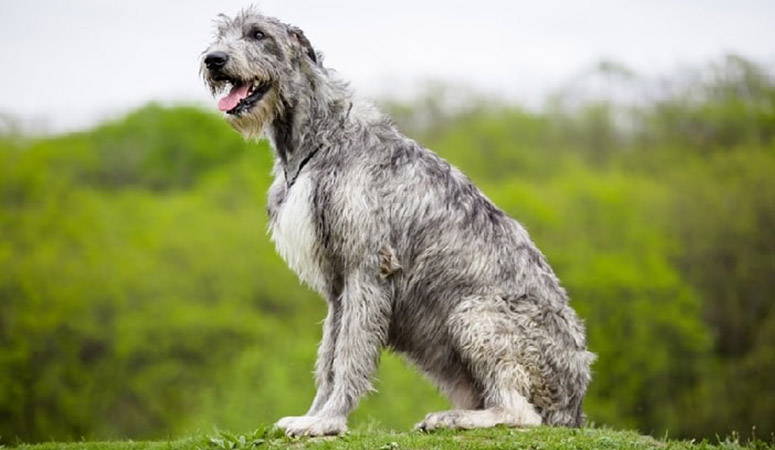
Originally used in war to drag men off horses and chariots, the Irish Wolfhound is dignified, calm and kindly, also the tallest of all AKC breeds. With the character of fearless, they hunted large game such as deer, boar, and wolves. Today, they compete in obedience, tracking, and lure coursing, which make them agreeable family companions.
| Other Names | Cu Faoil |
| Color | White, Black, Blue, Brindle, Cream, Gray, Gray & Brindle, Silver, Wheaten, Wheaten & Brindle, Red, Red & Brindle, Red Wheaten, |
| Height | Males: 31-32 inches. Females: 28-30 inches. |
| Weight | Males: 100-125 pounds. Females: 89-105 pounds. |
| Life Span | 6-8 years |
| Personality | Courageous, Dignified, Calm |
| Exercise | Regular Exercise |
| Origin |
| Popularity | #76 |
| Groom Needs | Weekly Brushing |
| Kids Friendly | Yes with supervision |
| Dog Friendly | Yes with supervision |
| Watch Dog | |
| Family Dog | Yes |
| Litter Size | 4 to 8 puppies |
Irish Wolfhound Pictures
Irish Wolfhound Video
Introduction
Today’s Irish wolfhound is a family companion who loves to compete in obedience and tracking trials. He is known as the Heartbreak Breed simply because you fall in love with him very deeply. He is one of the tallest dogs in the world, but other dogs will be heavier than him. He stands around 35 inches at the shoulders and weighs in at around 180 pounds. He loves his long walks which is very important to keep his big body maintained. That means he needs plenty of space to move around in and thrive. He is not the ideal watchdog because he doesn’t bark a lot. He is brave, but not aggressive, therefore not a guard dog by nature. The Wolfhound’s coat is rough and hard, coming in colors such as gray, brindle, red, black, white, or fawn. His coat needs to be brushed weekly to keep it healthy. Also remember, if you have kids, no dogs are roughhouse toys. He is no pony, no matter how small the child is. His body is not designed for strain like that or for pulling carts either.
Living with Irish Wolfhound
The Irish Wolfhound requires little to keep its wiry hair. The rough coat needs weekly brushing to remove dirt and loose hair and keep the dog looking his best. Also occasional bathing is necessary.
They just need shedding year-round, but seasonal shedding their undercoat is not advisable. Stripping the coat occasionally through the year helps maintain the breed’s natural look. Minimal trimming with scissors helps keep the shaggy hair neat.
Overly long nails can be painful to the dog and cause problems walking and running. Trimming nails regularly will help prevent painful splitting and cracking, or breaking a nail.
His ears should be checked weekly for redness or a bad odor, which can indicate an infection.
The large breed needs exercises throughout their lives. The owner should take the Irish Wolfhound out for a walk or run at least twice a day, but they shouldn’t be taken on walks until they’re at least six months old. The breed can also exercise mind and body by participating in canine sports like tracking, agility, and lure coursing.
Irish Wolfhound adults enjoy a walk and need a couple of 20-minute play times where they can run freely every day. But you should avoid any exercise an hour before meals or two hours after meals, which will increase the risk of gastric torsion, or bloat.
Although with high-energy, the dogs are likely to snooze at your feet after at least 40 minutes of daily exercise and play. And they probably develop a lazy attitude, but encouraging exercise will keep them in the best condition.
With a strong instinct to hunt and chase prey, they should only be allowed to loose in areas that are securely fenced, and any walks must be taken on a leash. He will feel happy if you give him access to a securely fenced yard where he can run. Tie-outs are not suitable for the Irish Wolfhound as they will not withstand more than a single tug from this massive dog.
The recommended diet for most Wolfhounds is about four to eight cups of high-quality dry food every day, but the amount of the given food should change with its size, age, metabolism and activity level. The better the dog food is, the further it will go toward nourishing your dog.
A raised feeder and limiting activity of one hour after meal can help prevent dangerous condition, such as gastric torsion, or bloat. Keep your Irish Wolfhound in good shape by measuring his food and feeding him twice a day rather than leaving food out all the time.
Wolfhounds do not tend to guard their food, but children should never be allowed to touch or remove food while any dog is eating.
Check with the dog’s breeder and your vet if you have any problems or concerns about your dog’s weight, diet, or feeding schedule.
Generally The Irish Wolfhounds are healthy, but sometimes they are prone to some different health problems, such as cancer, liver shunt, von Willebrand’s disease, hip and elbow dysplasia, heart disease and bloat. The breeder should learn about their symptoms and know what to do when these diseases occur.
To keep your Irish Wolfhound in good health, be sure to take your dog out for regular exercise and visit the veterinarian when needed.
Brush your dog’s teeth at least two or three times a week to remove tartar buildup and the bacteria that lurk inside it. Of course daily brushing is even better to help prevent gum disease and bad breath.
Responsible breeders will screen their breeding stock for health and genetic conditions regularly. Annual examination, such as hip, elbow, ophthalmologist evaluation and cardiac exam should be done by a veterinarian familiar with sighthounds.
Total Annual Cost: $3889.6
Cost is estimated for the first year and may vary depending on many factors, such as dog food, health care, leash, collar, licensing, possible fencing, crates, training and obedience classes, dog-walking, grooming, treats, toys, flea, tick, and heart-worm meds, microchips, etc.
Intelligent and loves to please, it’s easy to train an Irish Wolfhound, and beginning from his puppyhood will make it easier. Make sure to socialize your Irish Wolfhound with other dogs and people from his young age so that it does not become frightened. Irish Wolfhounds excel at advanced obedience, lure coursing, and tracking.
Leash training is very important because as your dog grows bigger, it will drag you easily along on its leash, so you should start your training with leash control as early as possible. The Irish Wolfhound likes to pull on the leash, so you need to teach your dog that this behavior is unacceptable.
They’re generally easy to housetrain, and crate training is a great aid to housetraining, which will help keep your belongings safe, but it shouldn’t be overused, or his joints may be damaged.
With smartness, you can reward it with a treat when your dog follows a command, while firmly but positively correct the behavior if he does something wrong and you should give a lot of patience and consistence.
History
Yes, you guessed right, the Irish Wolfhound originates from Ireland.
He once upon a time was used during the wars to help to drag men off their chariots and their horses – that’s how big he was! Apart from those duties, he also was used to hunt large game like wolves, and deer and boars.
Roman consul Aurelius wrote in 391 AD that “all Rome viewed with wonder” the seven Irish Wolfhounds that he received as a gift. They proved fearsome in battle, pursued Irish elk which were six feet at the shoulders. They were also fearless hunters of the wolf – from which they got their name. Before that though, he was just called Cu. That’s a Gaelic name probably meaning hound, wolf-dog, or war dog.
A favorite tale about this amazing dog is that of the Prince of Wales, Llewellyn, in 1210. His hound, Gelert, accompanied Llewellyn on a hunting trip. His job was to guard Llewellyn’s baby son while he was gone. On returning, he found the baby’s crib overturned. Gelert was covered in blood. Furious, Llewellyn slew Gelert, only to hear the cry of his son near a wolf that Gelert had killed. Llewellyn, overcome with grief, mourned his dog forever, erecting a tomb in Gelert’s honor. It can be seen in Caernarvon, Wales.
The first Irish Wolfhound was registered with the American Kennel Club in 1897.
Helpful Information
Breed Club: IRISH WOLFHOUND CLUB OF AMERICA
Breed Club Link: http://www.iwclubofamerica.org/
Breed Club Rescue: Irish Wolfhound Club of America Rescue Committee
Breed Club Rescue Link: http://www.iwclubofamerica.org/rescue

